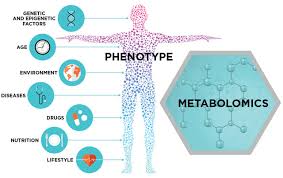 Metabolomics is the study of chemical processes involving metabolites: the small molecule substrates, intermediates, and products of cell metabolism.
Metabolomics is the study of chemical processes involving metabolites: the small molecule substrates, intermediates, and products of cell metabolism.
Metabonomics applies the scope of systems biology to studies of metabolism.
Metabonomics is the quantitative measurement of the dynamic metabolic response of living systems to pathophysiological stimuli or genetic modification.
It refers to the study of the global metabolic profile within a cell or tissue.
Metabolic profiling represents the current biological state.
It is the systematic study of the unique chemicals that specific cellular processes leave behind.
It is the study of the small-molecule metabolite profiles of cells.
The metabolome represents the complete set of metabolites in a biological cell, tissue, organ, or organism, which are the end products of cellular processes.
Messenger RNA (mRNA), gene expressions, and proteomic analyses reveal the set of gene products being produced in the cell, represents one aspect of cellular function.
Metabolic profiling provides a view of the physiology of that cell.
Metabolomics provides a readout of the physiological state of an organism.
There are quantifiable correlations between the metabolome and the other cellular genomes, transcriptomes, proteomes, and lipidomes, which can be used to predict metabolite abundances in biological samples from, for example mRNA abundances.
The metabolome refers to the complete set of small-molecule (<1.5 kDa) metabolites, such as metabolic intermediates, hormones and other signaling molecules, and secondary metabolites, to be found within a biological sample.
The metabolome is dynamic, changing from second to second.
It is not currently possible to analyze the entire range of metabolites by a single analytical method.
The first metabolite database is called METLIN for searching fragmentation data from tandem mass spectrometry,and contains over 450,000 metabolites and other chemical entities.
The Human Metabolome Database (HMDB) stores more than 110,000 different metabolite entries, cataloging approximately 1200 drugs and 3500 food components that can be found in the human body.
Each type of cell and tissue has a unique metabolic portrait that can elucidate organ or tissue-specific information.
Bio-specimens used for metabolomics analysis include: plasma, serum, urine, saliva, feces, muscle, sweat, exhaled breath and gastrointestinal fluid.
These bio-specimens are easy to collect, and are because they are always at dynamic equilibrium with the body, they can describe the host as a whole.
Analysis of the genome can tell what could happen.
The transcriptome can tell what appears to be happening.
The proteome can tell what makes it happen.
The metabolome can tell what has happened and what is happening.
Metabolites are the substrates, intermediates and products of metabolism.
A metabolite is usually defined as any molecule less than 1.5 kDa in size.
Exceptions to this definition depend on the sample and detection method.
Macromolecules such as lipoproteins and albumin are reliably detected in metabolomics studies of blood plasma.
Metabolites are either endogenous or exogenous.
Metabolites of foreign substances such as drugs are termed xenometabolites.
The metabolome is a large network of metabolic reactions: outputs from one enzymatic chemical reaction are inputs to other chemical reactions.
Metabolites are quantified by liquid chromatography or gas chromatography coupled with spectroscopy.
Bioinformatic tools and software are available to identify associations with disease states and outcomes, significant correlations, and characterize metabolic signatures with existing biological knowledge.
The ability to analyze metabolites directly from biofluids and tissues is challenging because of the limits imposed by the complexity of these samples, which contain thousands to tens of thousands of metabolites.
Toxicity assessment/toxicology by metabolic profiling of urine or blood plasma can detect the physiological changes caused by toxic insult of a chemical(s).
Metabolomics can help determine the phenotype caused by a genetic manipulation, such as gene deletion or insertion.
There is potential for predicting the function of unknown genes by comparison with the metabolic perturbations caused by deletion/insertion of known genes.
Metabologenomics can integrate metabolomics and genomics data by correlating microbial-exported metabolites with predicted biosynthetic genes.
Metabolomics provides steady-state level information, while fluxomics determines the reaction rates of metabolic reactions and can trace metabolites in a biological system over time.
Nutrigenomics links genomics, transcriptomics, proteomics and metabolomics to human nutrition.
The metabolome is influenced by endogenous factors such as age, sex, body composition and genetics as well as underlying pathologies.
The large bowel microflora are a confounder of metabolic profiles and could be classified as either an endogenous or exogenous factor.
The main exogenous factors are diet and drugs.
Diet can then be broken down to nutrients and non-nutrients.
Metabolomics helps to determine a biological endpoint, or metabolic fingerprint, reflecting the forces on an individual’s metabolism.
